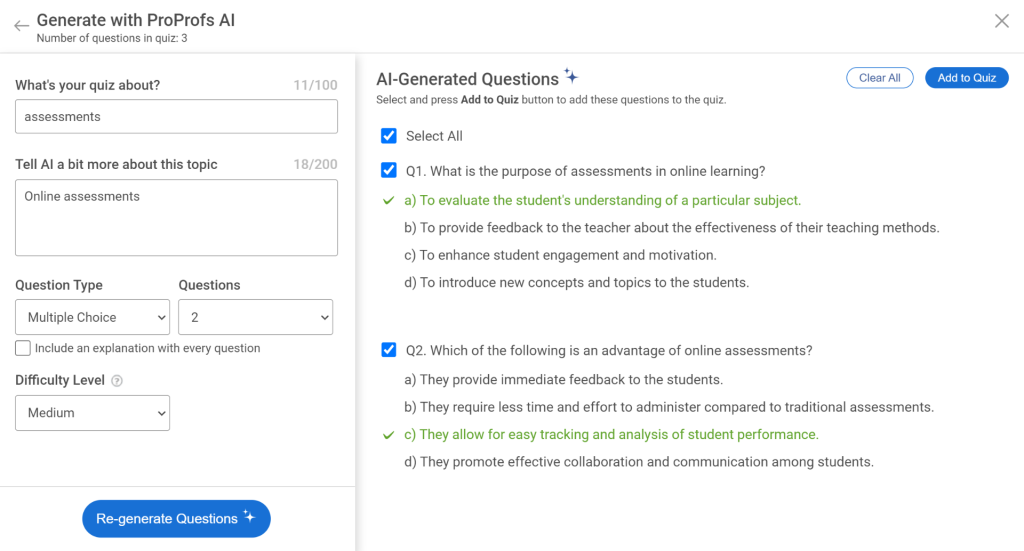
In the cutthroat world of recruitment and talent acquisition, where every decision matters, conducting pre-employment assessment tests emerges as a crucial and game-changing step.
These tests are valuable in ensuring your company doesn’t have to pay the price for a bad hire.
Did you know a bad hire can cost companies as much as $240,000? This staggering figure highlights the importance of finding the perfect fit for every company role.
That’s why recruiters and hiring managers constantly seek ways to optimize the hiring process and more efficiently identify top-performing candidates.
This is where pre-employment assessment tests come in.
Pre-employment assessment test provides invaluable insights into candidates’ abilities, skills, and suitability for specific roles.
By seamlessly integrating online pre-employment assessment tests into your hiring process, you can unlock a powerful advantage: the ability to make well-informed decisions, mitigate hiring risks, and pave the way for long-term success.
Let’s discover the significance of the pre-employment assessment test, its diverse types, and myriad benefits, and embrace the best practices to streamline your hiring strategy like never before.
What Is a Pre-Employment Assessment Test?
Pre-employment assessment tests are standardized questions that help gather relevant data on candidates during the hiring process. They are a reliable means of gaining insights into the capabilities and traits of prospective employees.
These tests have become wildly popular in recent years as businesses that use online assessment software have a leg-up against those that don’t.
That is because a pre-employment test includes (but is not limited to):
- Video Introductions
- Personality Assessment
- Skill Assessment
- Knowledge Assessment
Assessment tests help you get a holistic view of your candidates and, most importantly, a data-based ranking system. So, you don’t make the hiring move only based on your gut feelings!
Watch: How to Create an Assessment Online
What Are the Types of Pre-Employment Assessment Tests?
Depending on the type of test you use, pre-employment assessments can help provide data that you can use to determine a candidate’s ability to perform in the workplace. The most commonly used types of pre-employment tests are:
- Cognitive Aptitude Test
Cognitive aptitude tests predict how a candidate will perform on the job based on their cognitive abilities. The candidates’ answers in the test can help you learn how they can handle and respond to challenging situations.
The General Aptitude Test, commonly known as GAT, is a perfect example of a pre-employment assessment test that assesses a candidate’s cognitive aptitude; it tests logical, verbal, and analytical ability.
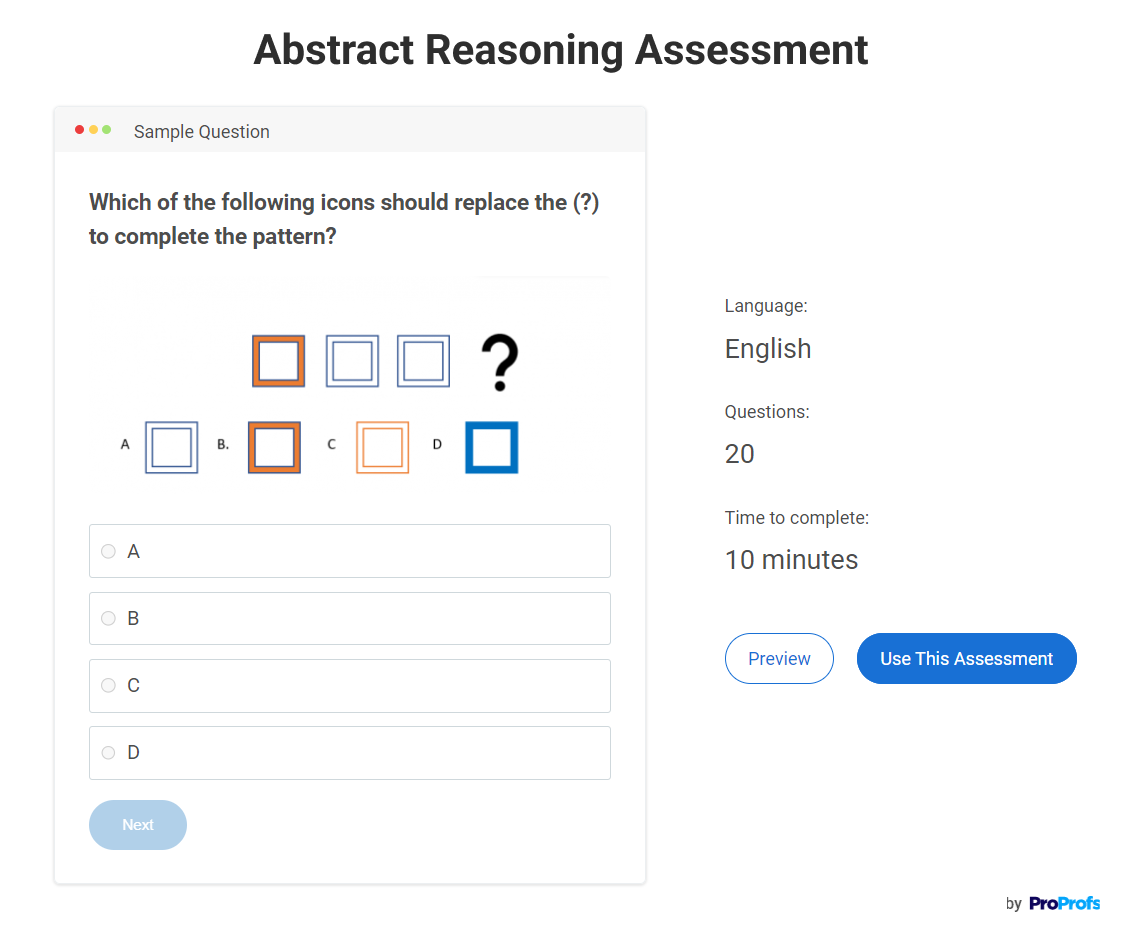
- Skills & Knowledge Test
Skill tests and knowledge tests are used to assess if the candidate has the essential skills and knowledge required to perform a particular job.
With a skill test, you can assess the level of knowledge and skill the candidate has mentioned on their resume.
For example, you want to hire a candidate for the role of social media manager. In that case, you can use a social media marketing skills assessment to assess your candidates’ social media management.
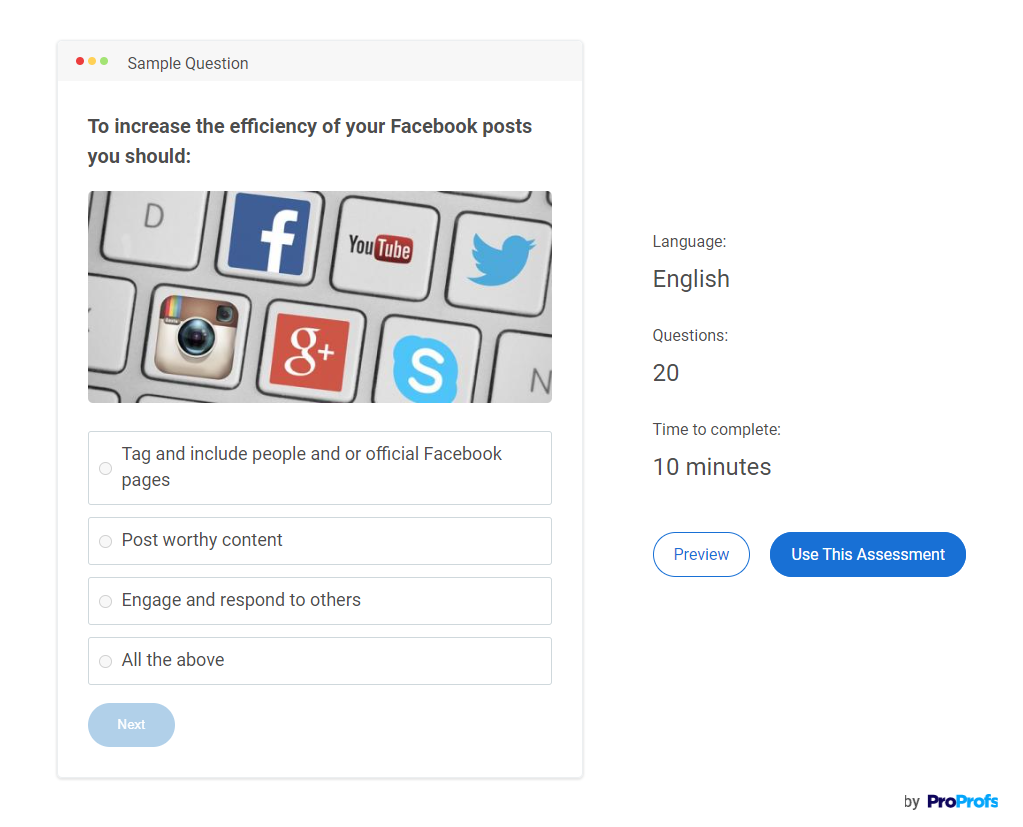
- Personality Assessment
Personality assessments or personality tests are commonly used to assess if candidates fit within the company’s culture.
You can use this assessment to see if the candidate has traits like extraversion, agreeableness, conscientiousness, openness to experience, and neuroticism.
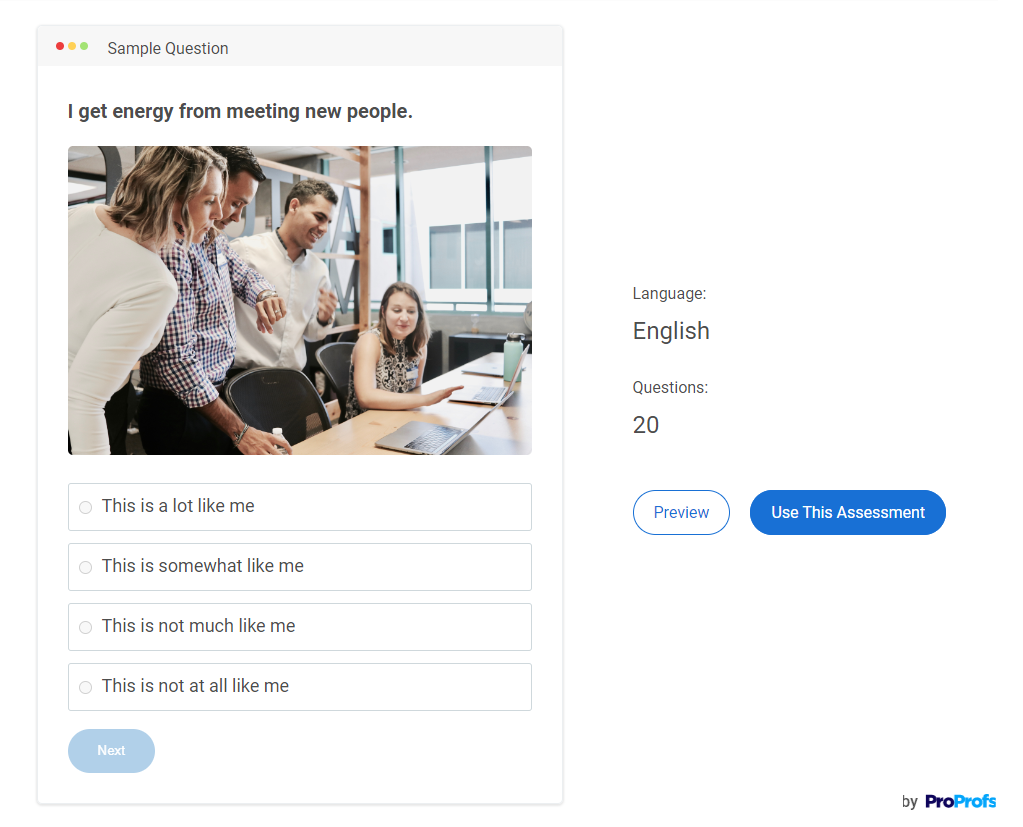
These are some of the most popular pre-employment personality tests used by employers:
- The Caliper Profile
- The Myers-Briggs Type Indicator
- The SHL Occupational Personality Questionnaire
- The Hogan Personality Inventory (HPI)
- The DiSC Behavioral Inventory
- Emotional Intelligence Tests
An emotional intelligence test assesses the candidate’s ability to understand other people’s emotions and their own.
Emotional intelligence forms the core of successful teamwork and is thus an essential trait for leadership and managerial roles.
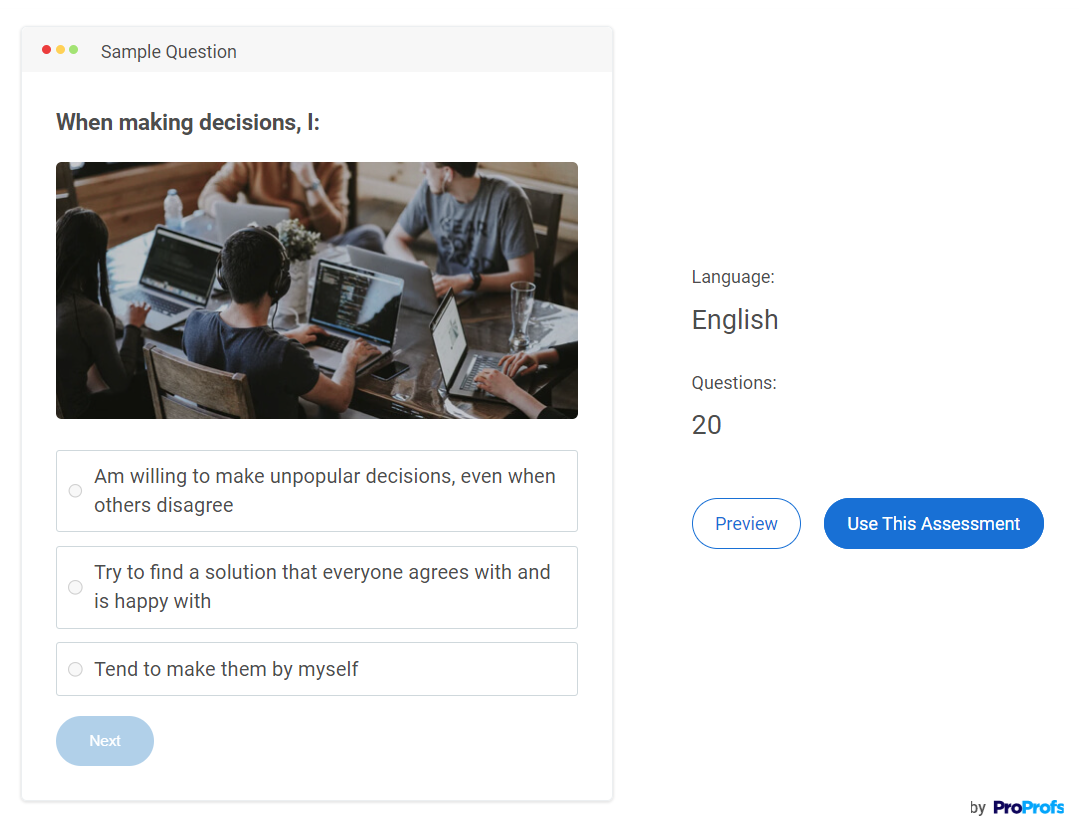
- Soft Skills Assessment
Hard or technical skills aren’t the only skills you want to assess when hiring someone. You must also test soft skills like communication, time management, etc.
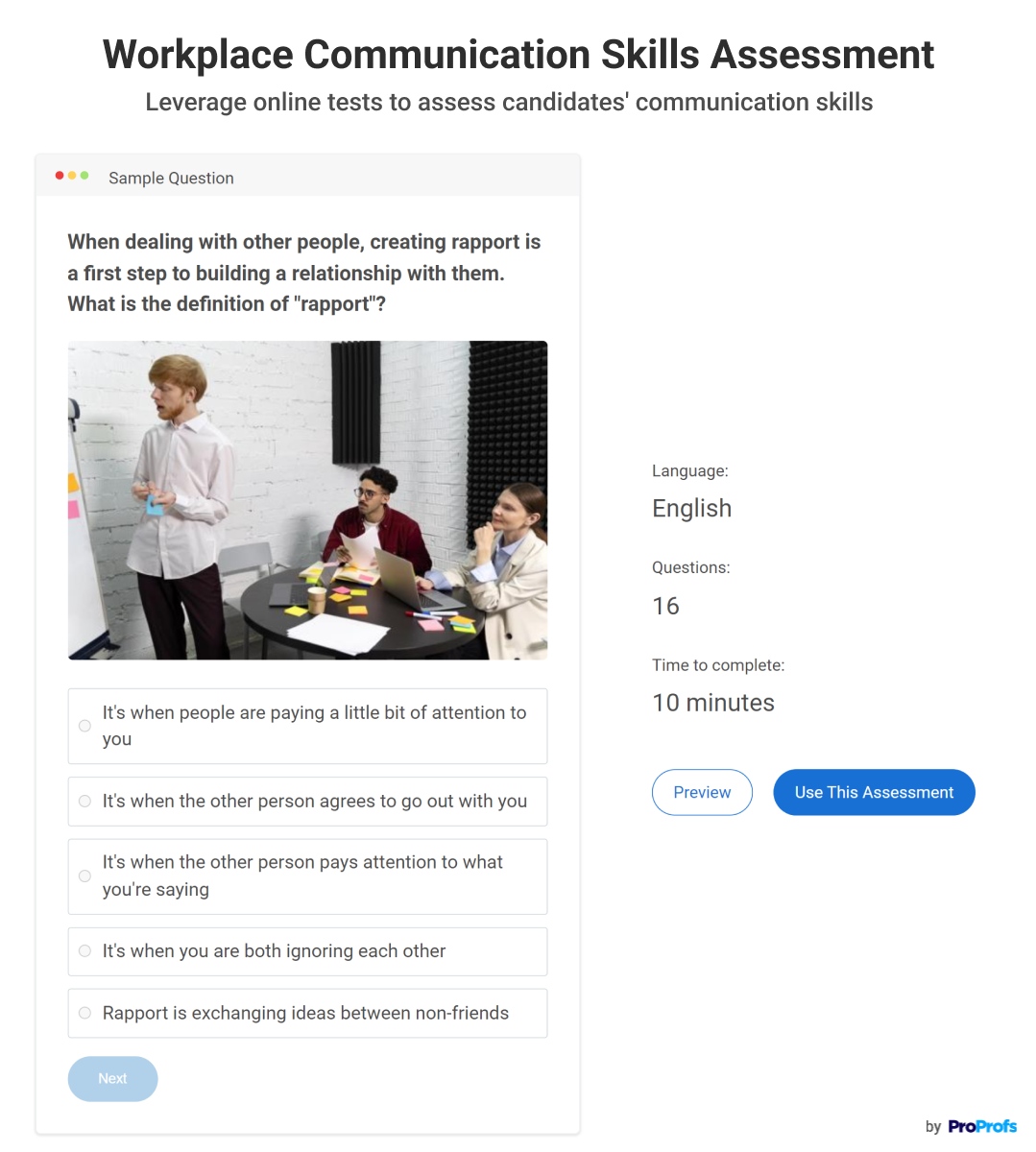
Assessing soft skills enables you to hire candidates who not only possess the required knowledge for a position but also have the characteristics to collaborate effectively and be consistently productive.
Here are the top soft skills you need to look for in candidates:
- Workplace communication
- Time management
- Change management
- Leadership skills
- Email etiquette
- Conflict resolution
- Business etiquette
- Project management
- Social skills
- Negotiation skills
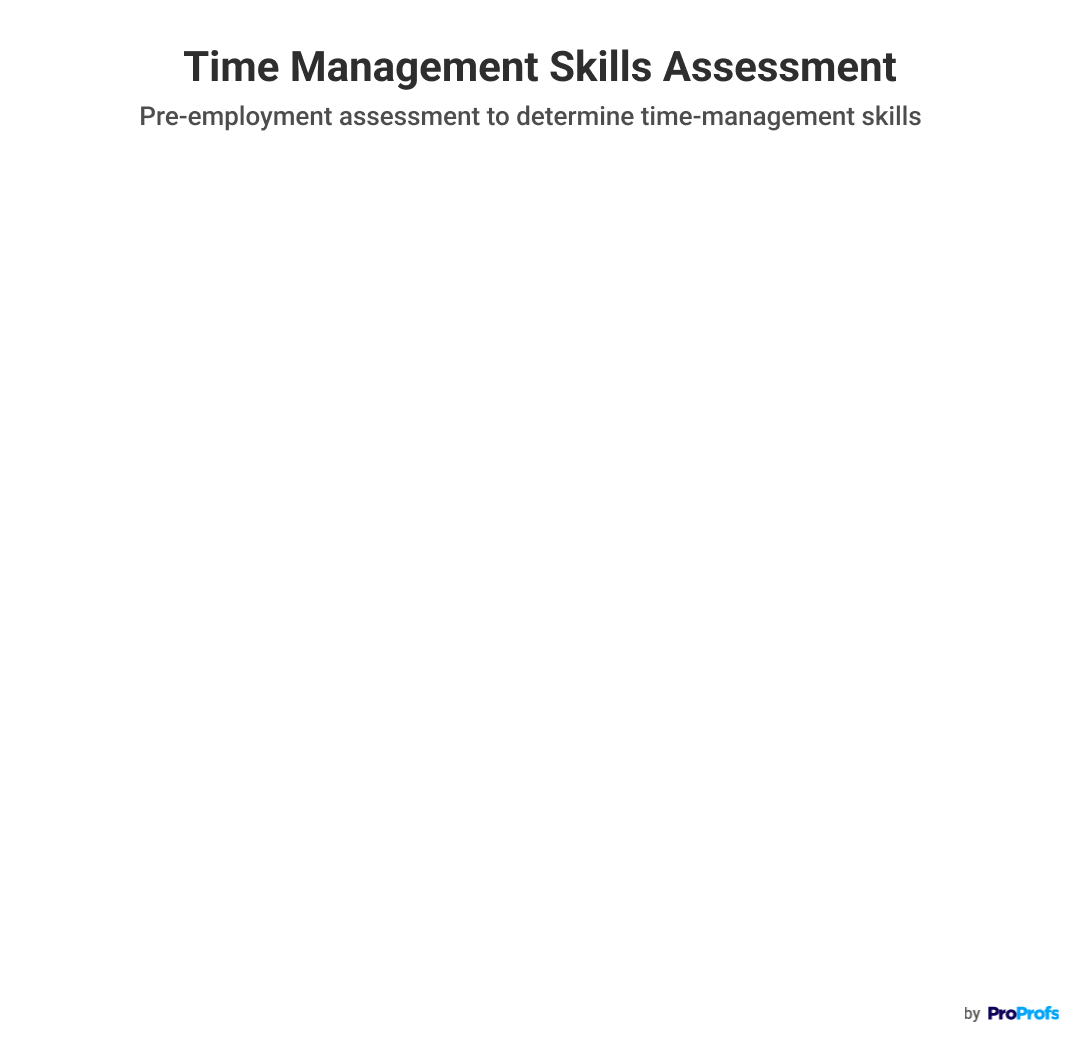
- Safety & Compliance Assessments
Training new employees on compliance regulations and matters related to workplace safety and health is a key component of every employee onboarding program.
Considering how important it is to ensure safety and compliance in business, it is best to hire candidates with a good knowledge of these subjects.
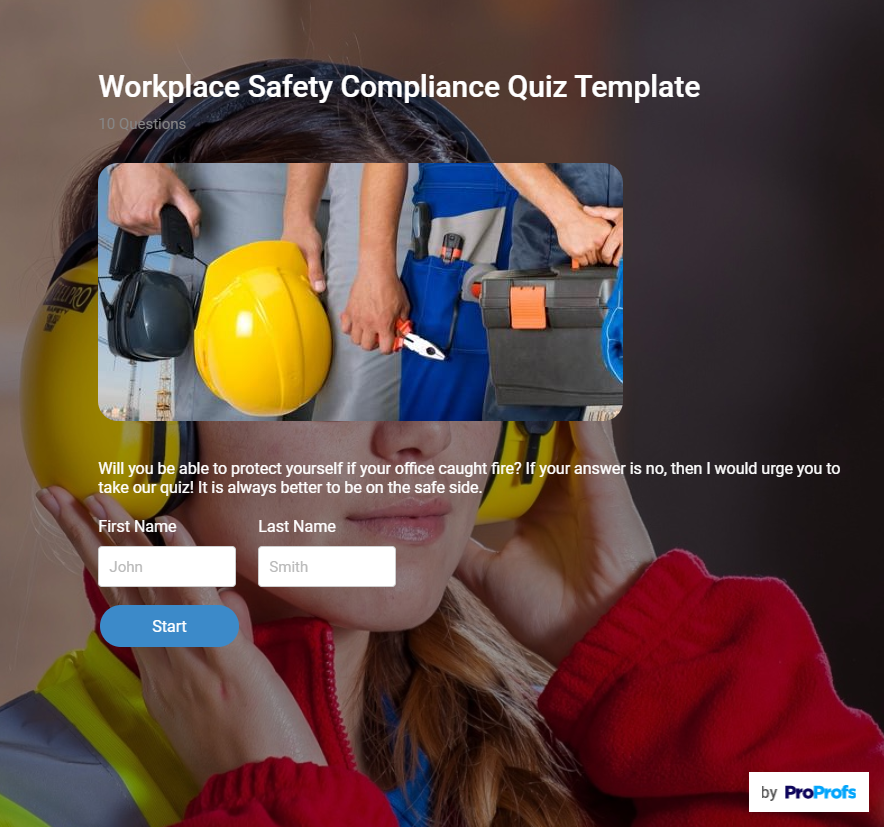
By doing this, you can reduce training time for new employees and onboard people who are safety-minded and follow the law, quickly making them part of your compliance culture.
- Conflict Management Style Assessment
A conflict management style assessment lets you determine a person’s way of dealing with workplace disagreements.
You can include this assessment as part of your recruitment process to enable leaders to manage new employees better and train them on conflict resolution skills according to their conflict style.
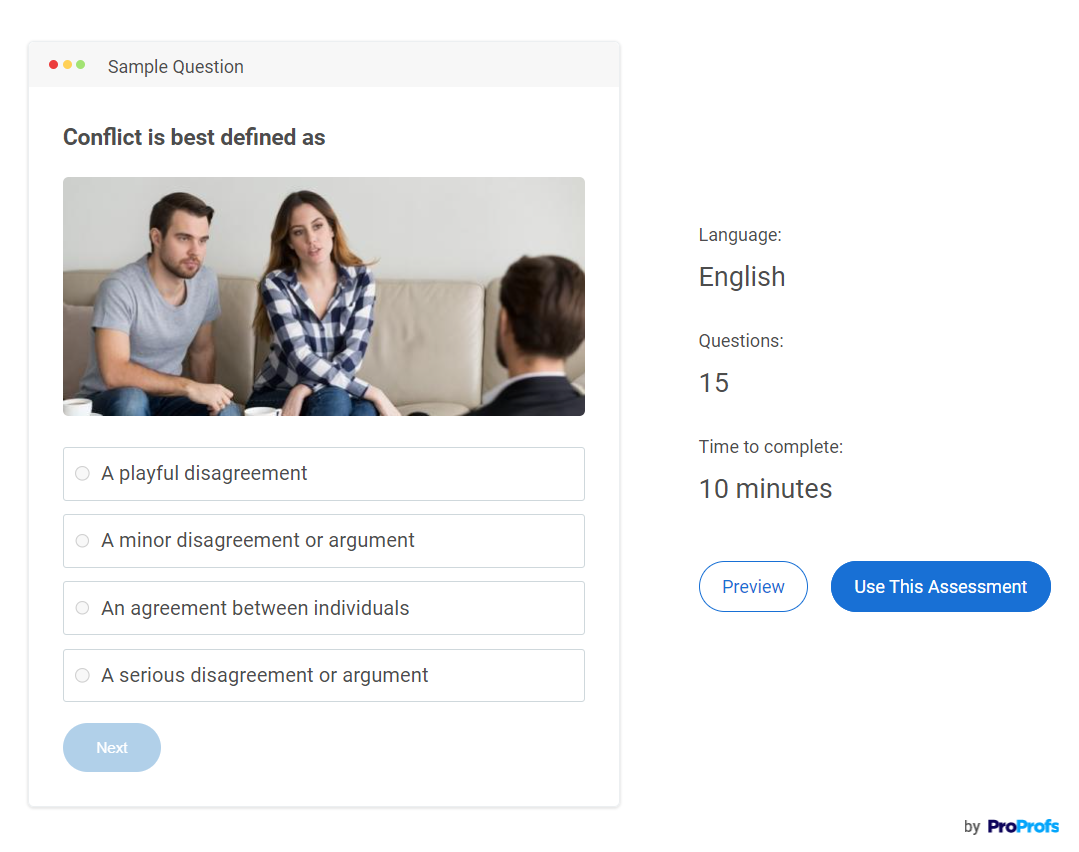
Related Read:How to Create a Conflict Management Style Quiz
- Integrity Tests
Integrity tests are used to determine how reliable an applicant is regarding integrity and ethics. For example, an integrity test may include the following questions:
- What would you do if a manager assigned you a task that breaches company policy?
- Is it okay from an ethical standpoint to publish work samples on one’s website?
- Have you ever lied to a reporting authority in a previous job?
- Would you do something illegal to satisfy a client?
You can conduct an integrity test in a couple of different ways:
- Conduct a video interview quiz and ask the candidates to give a comprehensive answer to your questions by recording videos.
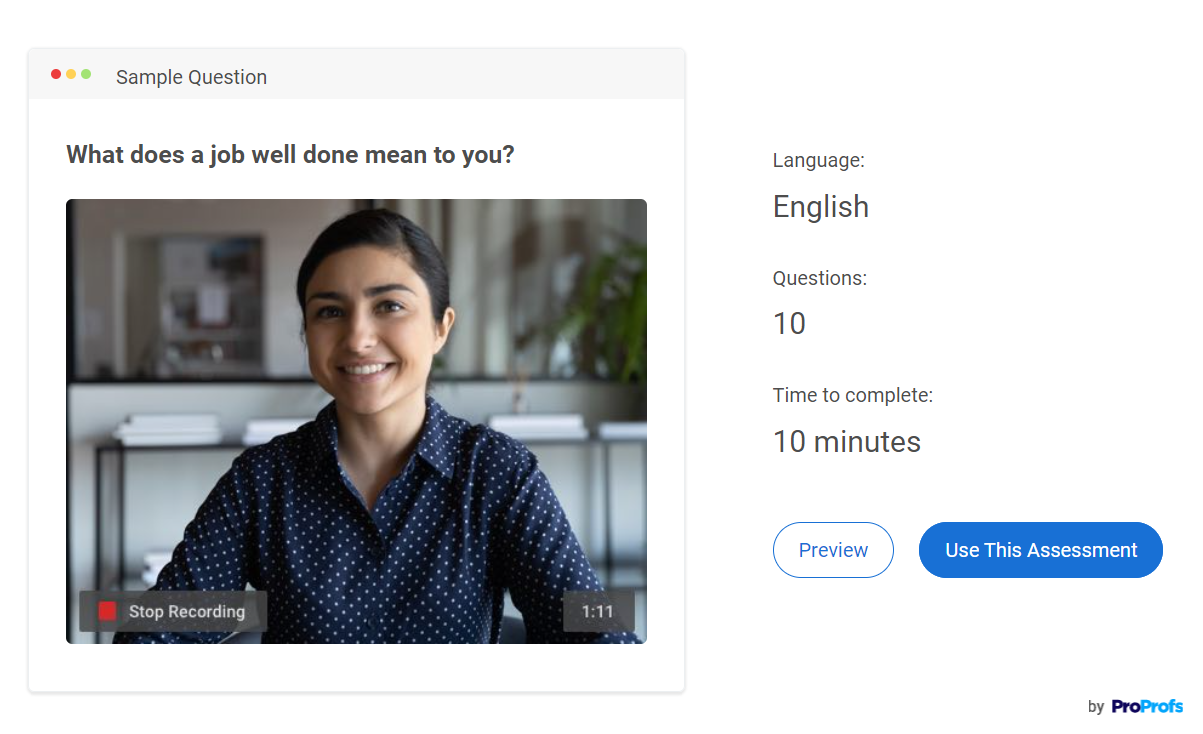
- Conduct an assessment test to check candidates’ knowledge about integrity, ethics, and business conduct.
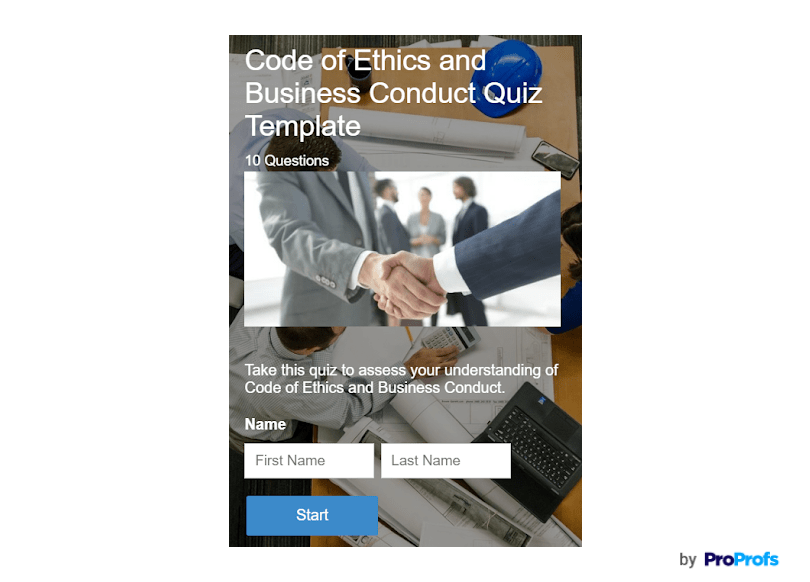
These are the types of pre-employment tests you can create with online assessment software. Now, let’s understand why you must use these different types of pre-hire tests.
Why Are Pre-Employment Assessments Important?
Pre-employment assessments are crucial because they provide an objective, systematic way to evaluate candidates, reducing reliance on subjective judgment.
These assessments identify candidates whose skills, abilities, and personalities align with job requirements and company culture, ensuring a better fit and promoting fairness and consistency in the hiring process.
For example, when hiring a software developer, a company can use coding tests to assess technical skills, cognitive tests for problem-solving abilities, and personality assessments for cultural fit.
This thorough evaluation ensures the selected candidate not only meets technical requirements but also integrates well with the team, contributing to long-term success.
How to Determine What Pre-Employment Testing Is Needed
Determining the appropriate pre-employment tests for your hiring process involves a thorough understanding of the job requirements and the specific attributes necessary for success in the role. The KSAO approach—Knowledge, Skills, Abilities, and Other Characteristics—provides a structured method to identify these requirements.
Knowledge
Knowledge refers to the information required to perform a job. This includes a theoretical and practical understanding of a subject. To determine the knowledge needed:
- Job Analysis: Conduct a detailed job analysis to identify the key areas of knowledge required.
- Industry Standards: Refer to industry standards and benchmarks to ensure comprehensive coverage.
- Knowledge Tests: Use assessments that measure specific areas of knowledge relevant to the job, such as technical expertise, regulatory understanding, or domain-specific information.
Skills
Skills are the proficiencies needed to perform tasks and duties effectively. These can be technical or soft skills. To determine the necessary skills:
- Skills Inventory: List the critical skills needed for the job, including both technical and interpersonal skills.
- Performance Indicators: Identify performance indicators that can be measured through skills assessments.
- Skills Tests: Implement tests that evaluate practical skills, such as coding tests for developers, writing assessments for content creators, or customer service simulations.
Abilities
Abilities are the innate capabilities required to perform tasks. These include cognitive and physical abilities. To determine the required abilities:
- Task Analysis: Break down the job into specific tasks to identify the abilities needed.
- Benchmarking: Compare against successful employees in similar roles to identify key abilities.
- Aptitude Tests: Use cognitive aptitude tests to measure abilities such as problem-solving, logical reasoning, and spatial awareness.
Other Characteristics
Other Characteristics include traits, values, and motivations that influence job performance. To determine these characteristics:
- Cultural Fit: Assess the company’s culture and values to identify traits that align with organizational goals.
- Behavioral Indicators: Identify behavioral indicators that predict success in the role.
- Personality and Integrity Tests: Utilize personality assessments and integrity tests to measure traits such as reliability, teamwork, and ethical standards.
Employing the KSAO approach, you can tailor your pre-employment assessment strategy to ensure you evaluate candidates on all critical aspects necessary for job success. This comprehensive evaluation helps you make informed hiring decisions, thereby building stronger and more effective teams.
Best Practices for Implementing Pre-Employment Testing
Before you create a pre-employment test and implement it into your hiring process, you must learn how to get the most out of it. Below, we’ve shared some pre-employment assessment test best practices that will help you make the smartest hiring decisions:
1. Choose the Right Test
You can’t use the same test for every job role you’re hiring for. Every job role requires a specific set of skills and knowledge. That’s why you must choose the proper test to assess your candidates.
Ensure that the test you choose has a range of questions that help you narrow down the focus of your assessment. You should test for skills, learn if they have the desired knowledge, and get to know them.
2. Validate the Test
Ensure the validity of the test you will use before you share it with the applicants.
Ask yourself:
Does the assessment include questions covering all the pre-employment testing aspects?
Does it include any unnecessary questions?
Eliminate any questions that do not serve your purpose to ensure the test you use for skill assessment is valid. The questions used in your assessment should help you evaluate the desired skills and predict the extent to which the candidate can perform the job.
3. Test at the Right Time
Timing is everything, especially when adding a skill test to your hiring process.
The candidates you interview are often not as technically skilled as the job role requires.
That’s when you realize all the time spent lining up the candidate for the interview has gone to waste.
So, when you create a skill test, you screen candidates in, not out.
If the volume of candidates is huge, filter the highly skilled candidates using smart reports and statistics.
This way, you can ensure that only candidates with the right skills for the job role progress further through the selection stages.
5. Track Completion Rates
With the job market at an all-time low, people spend an average of 11 hours scouting for a job to apply for. So, it’s quite natural to get burned out.
When conducting a pre-employment test, you allow the candidate to take a break from the stale interview experiences, rise above their resume, and showcase their personality.
While the candidates take their test, tracking the completion rates is your job.
With higher completion rates, you can expect to have a positive recruiting experience. Only the candidates genuinely interested in applying their skills to the job role will be moving forward.
You can also track the progress of your candidates and assess the difficulty level of your assessment by seeing which questions they skipped the most.
Accordingly, you can change or modify the questions in the test.
6. Use Fair Evaluation Criteria
Fair evaluation criteria ensure all candidates are assessed using consistent and unbiased standards. These criteria are based on job-related factors such as qualifications, skills, experience, and performance indicators.
Employing fair evaluation criteria can avoid discrimination, favoritism, or subjective biases in the hiring process and promote a transparent and merit-based selection process.
7. Establish Minimum Cutoff Scores
Establishing a minimum cutoff score can help minimize the chances of bad hires.
That is because the higher your cutoff score is, the more likely it is that candidates scoring above the cutoff will have the skills to excel in the job.
But how do you determine the correct cut-off score?
For that, we advise you to consider the specific dynamics of your hiring process, such as the size of your candidate pools, your applicant-to-hire ratio, and other factors.
But you must avoid setting it too high because it’ll probably filter out too many qualified people.
8. Provide Clear Instructions to Avoid Misunderstandings
You can avoid misunderstandings if you give clear instructions at the beginning of the pre-employment tests. Doing so ensures the recipients understand the expectations, requirements, and steps involved in a task or process.
Providing concise and specific instructions minimizes the chances of misinterpretation or confusion. This clarity promotes effective communication and allows individuals to follow instructions accurately, resulting in improved productivity, reduced errors, and a smoother workflow.
9. Use the Best Pre-Employment Testing Software
Well, this should have been listed at the top of the best practices, but here we are. We recommend using the best online assessment software to create and share pre-employment tests.
Why?
Because it’ll help you do the following:
- Create assessments in minutes (or even seconds)
- Shed the burden of writing down the right questions
- Help with automatic grading or scoring
- Provide detailed and insightful reports to speed up decision-making
- Test candidates no matter where they are and what device they use
- Make hiring more objective
- Manage candidate data by integrating with your HR software to keep the hiring process on track
Watch: How to Choose the Best Assessment Software
10. Collect Regular Feedback on Your Process During Onboarding
Regular feedback on your onboarding process is crucial to ensure a positive experience for candidates and new hires.
You can ask participants for feedback on the hiring process and pre-hiring assessments to gain actionable insights.
This feedback enables you to identify strengths and weaknesses in your onboarding process, address potential issues, and refine the program to better meet the needs of new hires.
Another way to approach this is by monitoring and analyzing test results and job performance data.
Related Read:Employee Feedback: 20 Great Examples & Its Importance
What Are the Benefits of Pre-Employment Assessments for Hiring?
An online assessment system provides much more value – and saves you much more time – than trying to create, administer, and score tests manually. These are some of the major benefits of using one:
1. Increased Efficiency
Do you know hiring professionals dedicate an astonishing two-thirds of their precious time to the arduous tasks of interview scheduling and candidate hunting? It’s time to break free from this inefficient cycle and discover a smarter way to streamline your hiring process.
The large pool of applicants makes it increasingly difficult for managers to handle the flow and identify the best candidates. Pre-employment tests can greatly streamline the hiring process.
Here’s how:
- These tests can save you time when placed at the top of the hiring funnel.
- With the help of AI-enabled test results, you can easily weed out underskilled candidates from the pool.
- Candidates who score high and complete the test are those you need to move forward.
- Setting a minimum cut-off score will help you narrow down the number of candidates to select for personal interviews.
- You can limit your hours on repetitive, time-consuming hiring activities and easily discover suitable candidates for the job.
What’s more, you can even get to know your candidates by creating video interview questions and adding them to your skill assessment tests.
Watch: How to Create a Video Interview Question
2. Quality Hiring
People differ in terms of physiological and psychological characteristics. But these differences can’t be seen or heard. You can only see their impact on other variables.
For instance, you can’t observe strength, but you can observe people with heavy lifting abilities, which is an indicator of strength. Similarly, you can’t observe analytical aptitude but measure it with a test.
Such differences in characteristics among people have important implications in the employment context.
Candidates who apply for a job role may vary widely in their knowledge, skills, abilities, interests, work styles, and other characteristics.
You can’t assess their skills or abilities by looking at their resume. But with a well-validated employment test, you can gather accurate information to determine if the candidate possesses the knowledge, skills, and abilities to excel at the job role you’re hiring for.
For example, applicants’ mechanical skills assessment test score will reflect their mechanical skills, knowledge, and ability.
You can use this score to predict how well that applicant is likely to perform in a job requiring mechanical ability, as demonstrated through a professionally conducted skill assessment test.
3. Increased Employee Retention
Pre-employment testing ensures that the candidates you hire have the adequate aptitude and skills required to perform the job well, along with a personality that will help them thrive in your organization.
These factors contribute to the candidate’s performance prediction in the long run and may reduce the likelihood of them being let go and quitting the job.
4. Avoidance of Costly Hiring Mistakes
One of the most important reasons you should use a skill assessment test is to avoid the cost of bad hiring.
The cost of hiring and letting go of the wrong candidate includes hiring costs, total compensation, eventual severance pay, and other factors, such as legal fees.
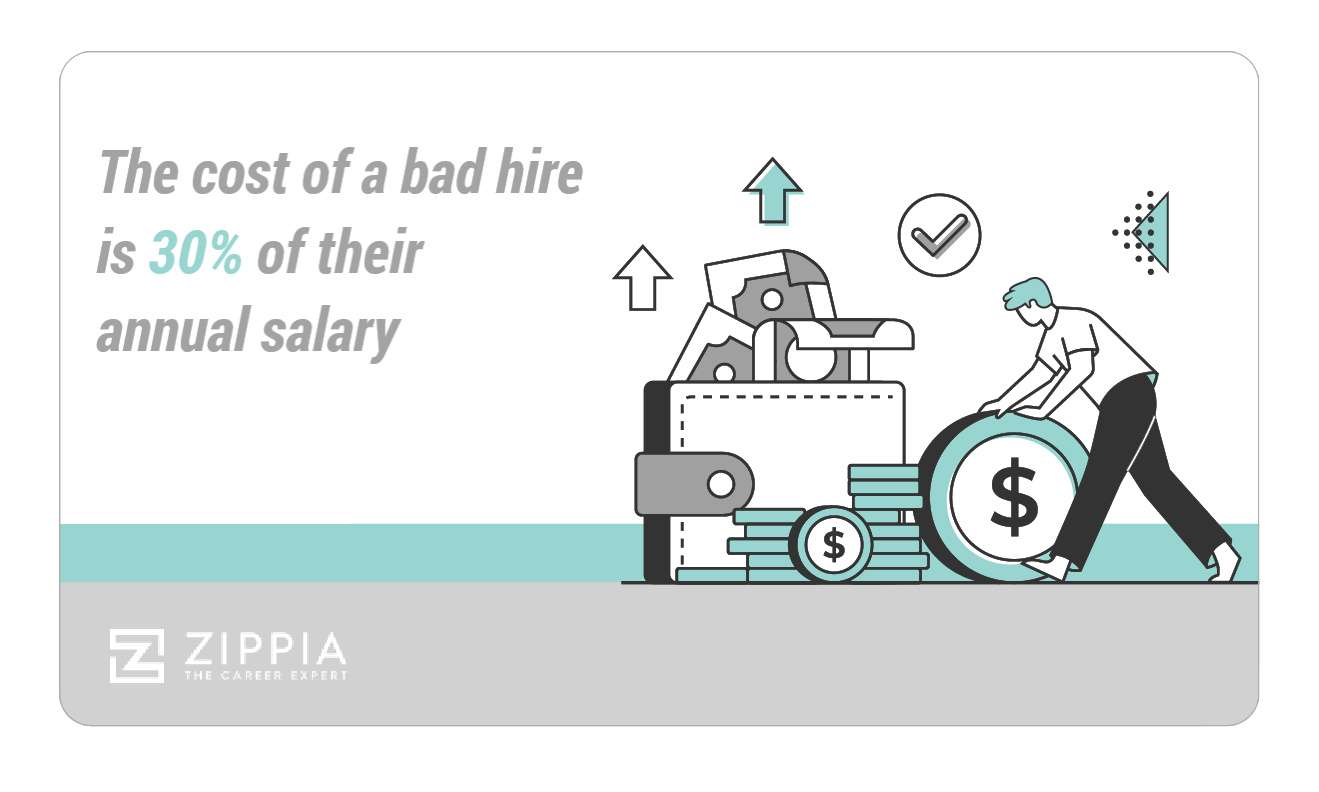
Since a pre-employment assessment involves assessing core traits and skills, it’s easier to hire the best candidates.
No matter what industry you’re in, seeing an increase in your company’s turnover will probably cause a spike in your blood pressure. Hiring and then replacing employees is costly and can result in more expenditure than the actual salaries.
Given the cost that high turnover rates can inflict on your business, you must seek effective methods of reducing them.
Resumes provide limited information, which isn’t enough to evaluate the true potential of candidates’ on-the-job performance.
On the other hand, a well-designed pre-employment test can provide you with much more accurate, objective information to evaluate your candidates.
You can assess their knowledge and skills accurately and determine how well they match the job role, which will increase the odds of hiring the right person for the job and ultimately reduce the turnover rate.
5. Easy Remote Hiring
Using online assessment software to conduct pre-hire tests and video interviews can make hiring people remotely much easier. That’s because online assessments are flexible. Candidates can take your assessments at a time and place that best suits them and don’t need to visit your or your staffing firm’s office.
While streamlining the remote recruitment process, an online assessment test also widens your candidate pool by enabling you to hire from any time zone.
6. Smoother Onboarding
The role and importance of pre-employment assessments aren’t limited to hiring. Conducting these tests also lets you onboard new employees efficiently, giving you a fair idea of a candidate’s personality, current knowledge level, and immediate training needs.
Armed with the knowledge of new employees’ skills and personalities, leaders and corporate trainers can craft more personalized onboarding and training programs to save time and money while improving the new team member’s experience.
7. Objective and Standardized Evaluation
Conducting a pre-employment test helps you make objective hiring decisions for fair and unbiased candidate selection. You can also standardize your selection process with the pre-employment tests and reduce subjective biases.
More so, the tests provide measurable data points for evaluating candidates against job requirements. Objective indicators of knowledge, skills, abilities, and cultural fit are prioritized, ensuring the selection of the most qualified candidates.
Objective hiring promotes transparency, equity, and diversity, enhancing the integrity of the recruitment process.
8. Predicting Job Performance
Pre-employment assessment tests are valuable tools for predicting job performance. They evaluate job-related skills, cognitive abilities, and personality traits that indicate success in a particular role.
By assessing these factors, employers can gain insights into candidates’ potential to excel in tasks, adaptability, and job fit. Cognitive ability tests measure mental agility and problem-solving skills, while personality tests reveal behavioral tendencies and interpersonal skills.
These assessments allow organizations to establish benchmarks, compare candidates, and make informed hiring decisions. However, using these tests in conjunction with other hiring methods is important.
9. No Room for Misrepresentation
Often, hiring managers hire candidates only because they have great skills mentioned in their resume. But do they possess those skills? How do you find out?
Business Insider found out in a survey that 72% of people lie on their resumes. So naturally, you can’t rely on the information candidates provide. But, what you can do is use a skill assessment test to see if they really possess the skills and knowledge mentioned in their resume.
Also, you can configure settings to prevent cheating on the test, and hence, rest assured that the candidates aren’t scoring using unfair means.
10. Narrowed Down List of Candidates
Gathering sufficient data on applicants allows you to use the test results to ask candidates specific questions related to their skills and work experience.
This exercise will help you quickly narrow down the number of applicants you’ll hire, especially if you have a lot of resumes to sort through.
| CASE STUDY: John Baker Sales John Baker, the owner and founder of John Baker Sales, uses pre-employment testing to hire smart people. John had earlier revealed that he struggled to find candidates who matched their hiring criteria, and asking them to take paper-based tests was a time-consuming process. However, using pre-employment tests created with an online test maker has made their hiring process much more efficient. In his words, “As a part of our pre-screening process, we send them a link to the same test that we create, and if they don’t meet our minimum score requirements, they are eliminated from a face-to-face interview. This approach has saved us countless hours over the past five years.”Read the full case study |
Disadvantages of Pre-Employment Tests & How to Overcome Them
While pre-employment tests offer many benefits, they also have certain disadvantages. Understanding these challenges and implementing solutions can help mitigate their impact.
- Potential Bias
Pre-employment tests can sometimes introduce biases, such as cultural or educational biases, that may unfairly disadvantage certain groups. To overcome this, ensure your tests are validated and designed to be culturally neutral. Regularly review and update the test content to eliminate biased questions.
- Inaccuracy in Predicting Job Performance
No test can perfectly predict a candidate’s future job performance. To address this, pre-employment tests should be used as one part of a comprehensive hiring process, combining test results with interviews, reference checks, and practical assignments.
- Over-Reliance on Testing
Relying too heavily on test results can lead to overlooking other important aspects of a candidate’s potential. To avoid this, balance test outcomes with other evaluation methods and consider the candidate’s overall profile, including experience and personality.
- Candidate Experience
Lengthy or complex tests can frustrate candidates, potentially deterring top talent. To enhance the candidate experience, keep tests concise and relevant. Clearly communicate the purpose and benefits of the assessments to candidates.
- Cost and Resource Intensive
Developing, administering, and scoring tests can be costly and resource-intensive. To manage costs, invest in scalable online testing platforms that offer automated scoring and integrate seamlessly with your hiring process.
By acknowledging these disadvantages and implementing strategic solutions, you can maximize the effectiveness of pre-employment tests while minimizing their drawbacks.
Efficiently Filter Candidates to Secure Top Talent
Pre-employment assessment tests offer a valuable solution for modern recruiters and hiring managers, allowing them to optimize their hiring processes and secure top talent.
By leveraging various pre-employment assessments, organizations can make informed decisions and avoid costly hiring mistakes, like the $240,000 price tag of a bad hire.
These tests streamline the candidate selection process, ensure fair evaluation criteria, effectively narrow candidate lists, and improve overall efficiency.
But there’s a catch—you need feature-rich online assessment software to create effective pre-employment screening assessments.
Ensure that your chosen tool offers customization, scalability, data security, and streamlined communication with candidates.
By adhering to best practices and leveraging the right testing software, you can harness the power of pre-employment assessments to make strategic hiring decisions and drive long-term success.
Frequently Asked Questions
What is the most common pre-employment test?
The most common pre-employment test is the cognitive ability test, which assesses skills such as problem-solving, critical thinking, and the ability to learn and apply new information. Other popular tests include personality assessments, skills tests, and job knowledge tests.
What do employers look for in a pre-employment assessment test?
Employers typically use pre-employment assessment tests to determine if a candidate possesses the specific skills, competencies, and personality traits necessary for success in the role. These assessments help gauge a candidate’s ability to perform job-related tasks, adapt to the company culture, and their potential for future growth within the organization.
What are the limitations of pre-employment tests?
The limitations of pre-employment tests include potential biases, such as cultural or educational bias, which can affect fairness and accuracy. The tests may not fully predict job performance and can sometimes exclude good candidates who may not test well but would perform excellently on the job. Additionally, over-reliance on these tests can overlook the holistic view of a candidate’s qualifications and potential.
How many companies use pre-employment assessments?
82% of organizations utilize these assessments as part of their hiring process. Their prevalence is driven by their utility in making the recruitment process more efficient and effective.
Do you want free Quiz Software?
We have the #1 Online Quiz Maker Software for complete learning & assessment





